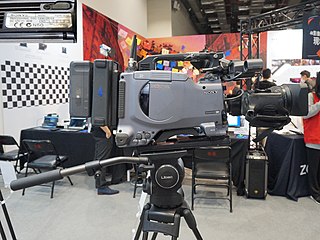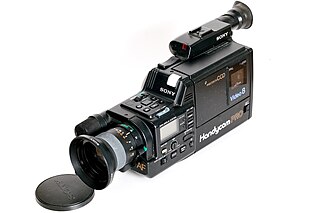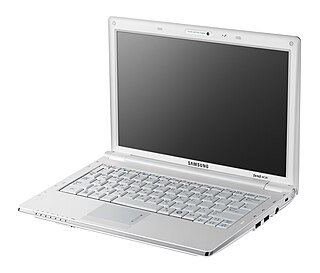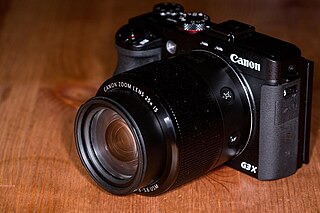Related Research Articles

A camcorder is a self-contained portable electronic device with video and recording as its primary function. It is typically equipped with an articulating screen mounted on the left side, a belt to facilitate holding on the right side, hot-swappable battery facing towards the user, hot-swappable recording media, and an internally contained quiet optical zoom lens.

HDV is a format for recording of high-definition video on DV videocassette tape. The format was originally developed by JVC and supported by Sony, Canon, and Sharp. The four companies formed the HDV Consortium in September 2003.

The Canon PowerShot G is a series of digital cameras introduced by Canon in its PowerShot line in 2000. The G series cameras are Canon's flagship compact models aimed at photography enthusiasts desiring more flexibility than a typical point-and-shoot without the bulk of a digital single-lens reflex camera.

XDCAM is a series of products for digital recording using random access solid-state memory media, introduced by Sony in 2003. Four different product lines – the XDCAM SD, XDCAM HD, XDCAM EX and XDCAM HD422 – differ in types of encoder used, frame size, container type and in recording media.

P2 is a professional digital recording solid-state memory storage media format introduced by Panasonic in 2004. The P2 card is essentially a RAID of Secure Digital (SD) memory cards with an LSI controller tightly packaged in a die-cast PC Card enclosure. The system includes cameras, decks as drop-in replacements for videotape decks, and a special 5.25-inch computer drive for random-access integration with non-linear editing systems (NLE). The cards can also be used directly where a PC card (PCMCIA) slot is available, as in most older notebook computers, as a normal hard disk drive, although a custom software driver must first be loaded.
AVCHD is a file-based format for the digital recording and playback of high-definition video. It is H.264 and Dolby AC-3 packaged into the MPEG transport stream, with a set of constraints designed around the camcorders.

Betamovie is the brand name for a range of consumer grade camcorders developed by Sony for the Betamax format. By "camcorder" is understood a single unit comprising a video camera and a video recorder.

SanDisk has produced a number of flash memory-based digital audio and portable media players since 2005. The current range of products bears the SanDisk Clip name. SanDisk players were formerly marketed under the Sansa name until 2014.

Sony Corporation produces professional, consumer, and prosumer camcorders such as studio and broadcast, digital cinema cameras, camcorders, pan-tilt-zoom and remote cameras.
General Imaging was a manufacturer of digital cameras headquartered in Torrance, California, established in 2006 by Hiroshi "Hugh" Komiya, a former executive of Olympus Corporation. General Imaging sold their cameras internationally under the General Electric name, used under license. General Imaging was licensed to manufacture and sell their cameras under the AgfaPhoto name in Japan. On October 5, 2015, General Imaging filed for bankruptcy.
MOD and TOD are recording formats for use in digital tapeless camcorders. The formats are comparable to XDCAM EX, HDV and AVCHD.

The Samsung NC20 is a subnotebook / Netbook computer designed by Samsung. At the time of its introduction,, it was the first mainstream netbook to use the VIA Nano processor and the first to support the x86-64 instruction set. The 12.1" screen size is larger than typical for this class of ultra portable PC. Its most direct competitors are the Lenovo IdeaPad S12 and the MSI Wind U210.

The Panasonic Lumix DMC-GH1 is a digital mirrorless interchangeable lens camera adhering to the Olympus and Panasonic developed Micro Four Thirds System (MFT) system design standard. Panasonic classified the GH1 as a hybrid stills/video camera and the GH1 was introduced and marketed as a higher end camera than Panasonic's first MFT camera, the stills only, non-video capable Lumix DMC-G1.
The Nokia C6-01 is a Symbian^3 smartphone from the Nokia Cseries. The C6-01 display features comes with a 3.2in AMOLED display with capacitive touchscreen capabilities and Nokia's ClearBlack technology for improved outdoor visibility. The smartphone was released on November 4, 2010 for €260, excluding taxes and subsidies.

The Panasonic Lumix DMC-GH2 is a digital camera with HD video recording capability that is part of the Micro Four Thirds system. Though commonly referred to as a DSLR camera, it has no mirror or optical viewfinder, but has instead both a fold-out LCD screen and a electronic viewfinder.
The Samsung Wave S575 which is the successor of Samsung Wave 525 is the smartphone running the new bada 1.1 Operating system designed by Samsung. Wave 575 was officially released by Samsung on 8 October 2010. The Wave has a slim multi-touch enabled display with 3G Internet connectivity available which is not available in its predecessor.

The Canon PowerShot G3 X is a large sensor digital bridge camera announced by Canon on June 18, 2015. It marks Canon's entry into this product category, alongside competitors such as the Panasonic Lumix DMC-FZ1000, Sony Cyber-shot RX10 and RX10 II.

The Sony Xperia XZs is an Android smartphone manufactured and marketed by Sony. Part of the Xperia X series, the device was announced to the public along with the Xperia XZ Premium at the annual Mobile World Congress last February 2017.